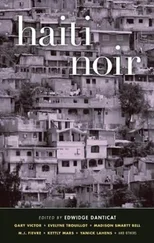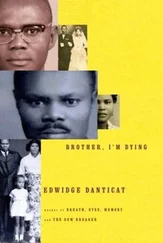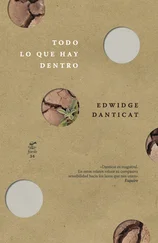Miraculously, my maternal grandmother’s house, the house where I spent parts of my summer vacations as a girl, is still standing. It had been rebuilt some years back, cement blocks replacing the wooden walls and tin roof I knew and loved. The outer wall around the property has collapsed. As has the house that my cousin Eli and his wife had recently bought a few feet away.
Since the earthquake, they had already built a tiny two-room house with wooden walls and a tin roof and a narrow porch in the middle of an open field in an area named Cité Napoléon, after my mother’s family. Eli’s new house looks like my grandmother’s old house, the one I’d loved.
Some time later, my last stop, before leaving Haiti, is at the compound in Bel Air where Maxo and his wife and children had been living. There is the church, my uncle’s chef d’oeuvre, which had been built nearly forty years earlier at street level and had cement walls and a triangular metal roof. Underneath the church, in a kind of basement that was on the same level as another street, were the classrooms for a small school. Behind the church was the two-level apartment where Maxo and his family lived. Over the years, Maxo had added two more stories and a few small rental apartments to the complex. During the earthquake, all of that crumbled and, when he was running from the street where his car was parked to the apartment where his wife and children were found, fell on top of him and the others.
No one is sure where Maxo’s son Nozial was, but it is believed that he had been playing where the rubble is most impenetrable, where all four stories piled up. Because Maxo was running when the building collapsed, he may have jumped or crawled into a place that made it easier to find his remains. The pile of rubble on top of the others made it impossible to extract theirs.
When I enter the church during my visit, I am amazed how little damage it appears to have sustained. Given that so many buildings around it had crumbled, its endurance seems part of some greater design, like the twenty-foot crucifix standing in the ruins of the collapsed Sacré-Cœur Church in the Turgeau neighborhood of Port-au-Prince.
The church is open and a group of men are huddled in the aisle in deep conversation when I walk in. One of them offers to show me Maxo’s makeshift grave.
I descend a cracked cement staircase, seeing through the fallen basement walls the foundations of the two houses on either side of me. It occurs to me that I am in a cavernous hole around which the earthquake crumpled everything else. Through the gaps in the wall I can see parts of the bottom of the rubble.
The danger of my being there suddenly hits home. So quickly, more quickly than I would have liked, I kiss my hand and then bend down and touch the cemented mound where Maxo had been buried.
Esther, the maternal cousin who had overseen his burial, had carved in the cement his name, his date of birth, and the day that he died, the day that so many died.
“We buried him there and I marked it,” she had told me on the phone, “so that whenever any of you come back from lòt bò dlo , you can see and touch his grave.”
I reach down and touch the grave again. I feel that I should perhaps say more prayers, intone more words, but frankly I am afraid. A massive church is resting on a shattered foundation around me. Should there be another aftershock, I could be crushed.
“Good-bye, Maxo,” I simply say. “Good-bye, Nozial.”
Emerging from under the church and into the sunlight, I remember thinking, each time I saw someone rescued from the rubble on television, that it looked a lot like a vaginal birth, the rescue teams nudging, like midwives, a head, then a shoulder, then some arms, and then some legs, out of the expanded earth.
Maxo and Nozial, I thought, were never reborn.
At Toussaint L’Ouverture Airport, I must show my American passport to get inside to meet the plane for the return trip. The first U.S. Customs and Border Protection officer at the airport entrance asks me to take off my glasses as he looks at my picture on the passport. He holds the passport up to the sunlight for some time to verify that it is not fake. I am embarrassed and slightly humiliated, but these, I suppose, are lesser humiliations compared to what my loved ones and so many others are going through. The second and third Customs and Border Protection officers are Haitian Americans who speak to me in Creole. They wish me a good return trip “home.”
On the plane, I listen quietly as the flight attendant thanks the doctors and nurses who are returning to the United States from stints as volunteers in Haiti.
“I bet you’re looking forward to hot showers and warm beds and U.S. ice,” she says.
The doctors and others clap and whistle in agreement.
“Well,” she says, “I can offer you one of those things. The U.S. ice”
Wrapping up, she adds, “God bless America”
Feeling overly protective of an already battered Haiti, I hear myself cry out, “God bless Haiti, too,” drawing a few stares from my fellow passengers.
The man in the seat behind me taps me on the shoulder and says, “Really. God bless both America and Haiti”
As we take off, I look down at the harbor, where a U.S military helicopter is flying between Toussaint L’Ouverture Airport and the USNS Comfort medical ship anchored just outside Port-au-Prince harbor. Further out to sea are U.S. Coast Guard ships, whose primary purpose is to make sure that Haitians are intercepted if they try to get on boats and head to the United States.
I have a copy of Les Nègres that I had meant to leave on Maxo’s grave under the church, but in my haste and fear I had forgotten and brought it back with me.
I turn my eyes from the Coast Guard ships, and now on the plane I open the book and begin reading, turning immediately to the page that, soon after I’d learned of Maxo’s death, had directly spoken to me: “Your song was very beautiful, and your sadness does me honor. I’m going to start life in a new world. If ever I return, I’ll tell you what it’s like there. Great black country, I bid thee farewell.”
Great black country, I too bid thee farewell, I think.
At least for now.
I am extremely grateful to the magnificent Toni Morrison for her kindness in having me present the second annual Toni Morrison lecture (March 2008), which led to this book. Thanks also to Eddie Glaude, Joelle Loessy, Valerie Smith, Chang Rae Lee, and Fred Appel for their assistance. And to Cornel West, the standard bearer. At last I have an opportunity to thank Marcel Duret for his promotion of Haitian culture in Japan and the enjoyable and informative trips there. Thanks also to Patricia Benoit, Fedo Boyer, Jim Hanks, Nicole Aragi, Kathie Klarreich, Project MediShare, Kimberly Green, and the Green Family Foundation. My thanks also to Daniel Morel for his time and his work. My deepest gratitude to the John D. and Catherine T. MacArthur Foundation. Thanks lastly, to Pascalle Monnin for the art used on the book cover.
Some of the chapters in this book appeared previously in the following publications:
Chapter 2 is taken partially from “A Taste of Coffee” in Calabash (May 2001). Other material is from an afterword to Breath, Eyes, Memory , by Edwidge Danticat (Random House Inc., 1999).
Chapter 3 is taken partially from The Butterfly’s Way: Voices from the Haitian Dyaspora in the United States , edited by Edwidge Danticat (Soho Press, 2003). Other material is from the article “Bonjour Jean” in The Nation (February 19, 2001).
Chapter 4 is taken partially from the foreword to Memoir of an Amnesiac by J. Jan Dominique (Caribbean Studies Press, 2008). Other material is from the introduction to Love, Anger, Madness: A Haitian Triptych , by Marie Vieux-Chauvet (Random House Inc., 2009).
Читать дальше












